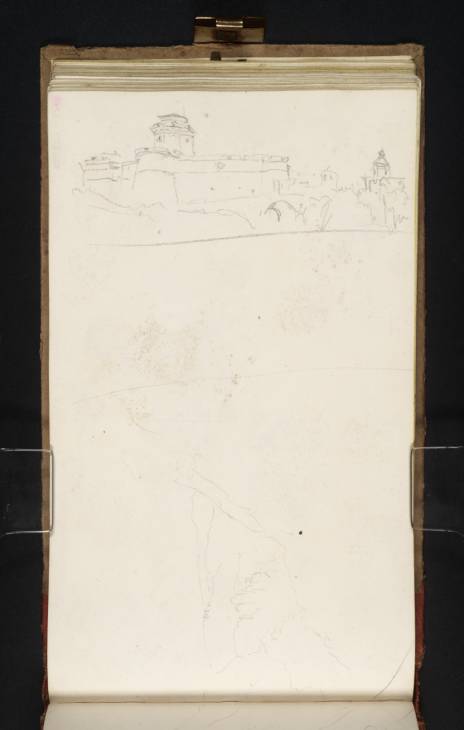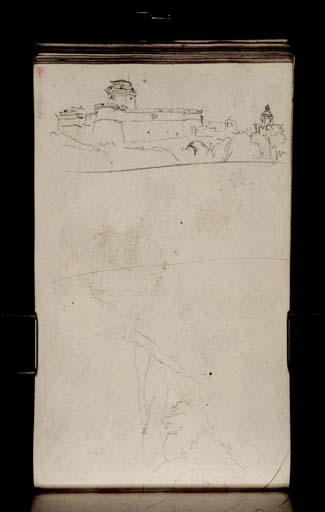Joseph Mallord William Turner The Forte Sangallo at Civita Castellana 1819
Image 1 of 2
Joseph Mallord William Turner,
The Forte Sangallo at Civita Castellana
1819
Joseph Mallord William Turner 1775–1851
Folio 68 Verso:
The Forte Sangallo at Civita Castellana 1819
D14786
Turner Bequest CLXXVII 68 a
Turner Bequest CLXXVII 68 a
Pencil on white wove paper, 186 x 110 mm
Accepted by the nation as part of the Turner Bequest 1856
References
1909
A.J. Finberg, A Complete Inventory of the Drawings of the Turner Bequest, London 1909, vol.I, p.523, as ‘A castle (?), and scene among hills’.
1984
Cecilia Powell, ‘Turner on Classic Ground: His Visits to Central and Southern Italy and Related Paintings and Drawings’, unpublished Ph.D thesis, Courtauld Institute of Art, University of London 1984, pp. 101, 469 note 143.
1987
Cecilia Powell, Turner in the South: Rome, Naples, Florence, New Haven and London 1987, p.34.
2008
James Hamilton, Nicola Moorby, Christopher Baker and others, Turner e l’Italia, exhibition catalogue, Palazzo dei Diamanti, Ferrara 2008, pp.44, 90 note 29.
2009
James Hamilton, Nicola Moorby, Christopher Baker and others, Turner & Italy, exhibition catalogue, National Galleries of Scotland, Edinburgh 2009, pp.42, 150–1 note 29.
The subject of this sketch is the Forte Sangallo, a Renaissance fortress which stands at the western tip of Civita Castellana, a town in the Viterbo province of Lazio, approximately seventeen miles south of Narni and thirty miles north of Rome. Named after its architect, Antonio da Sangallo the Elder (circa 1453–1534), this sandstone and brick building comprises an octagonal tower or citadel within a pentagonal bastion. It was also known as the Rocca dei Borgia, after Rodrigo Borgia, the future Pope Alexander VI, who commissioned the conversion of the existing castle into the imposing fortress, and during the nineteenth century, the building was used as a prison, earning it the name of the ‘Bastille of the Popes’. Turner’s sketch depicts the fortress from the south-west, on the road leaving Civita Castellana towards Nepi. To the right is the dome and lantern of the cathedral. The position of the drawing within the sketchbook disrupts the sequence of views of Narni and was clearly executed on a spare blank page at a later date. Other sketches of Civita Castellana can be found on folios 75 verso–79 verso(D14800–D14808).
The remainder of the page contains part of a horizontal landscape sketch, the continuation of the view from the opposite side of the double-page spread, see folio 69 (D14787).
Nicola Moorby
November 2008
How to cite
Nicola Moorby, ‘The Forte Sangallo at Civita Castellana 1819 by Joseph Mallord William Turner’, catalogue entry, November 2008, in David Blayney Brown (ed.), J.M.W. Turner: Sketchbooks, Drawings and Watercolours, Tate Research Publication, December 2012, https://www


